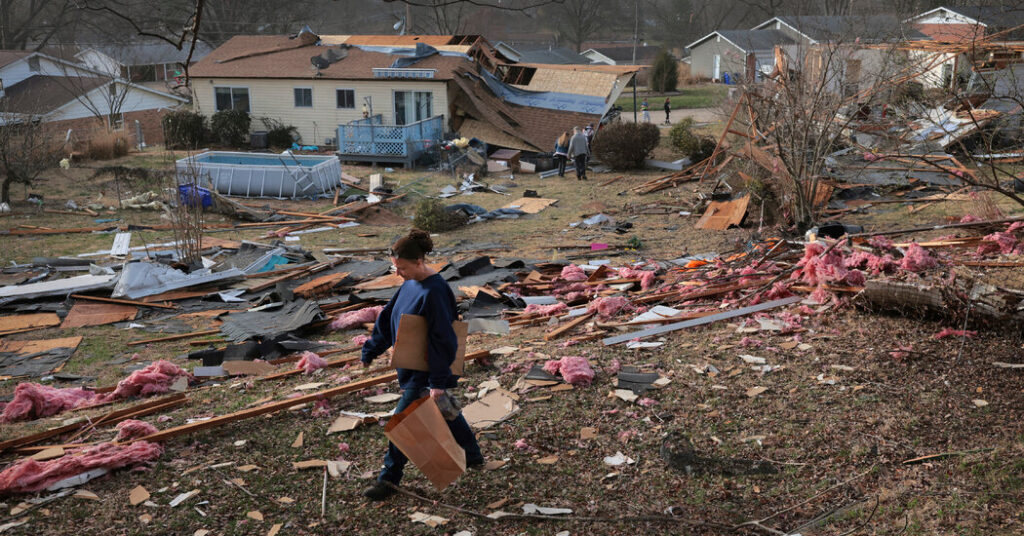St. Louis has been battered by two tornadoes in the past two months. A fire shut down a new nursing home last month in Enterprise, Ala., forcing residents to evacuate. Cleveland grappled with a power outage while inundated with visitors for the N.C.A.A. women’s basketball Final Four.
In each case, local health officials played a key role in containing the fallout, assisting hospitals, finding new homes for displaced residents, and coordinating efforts with fire, police and other city departments.
The funding for this work, about $735 million in total, comes from the Centers for Disease Control and Prevention. In President Trump’s proposed budget, the money has been zeroed out.
The proposed cut has left health officials increasingly alarmed, particularly since it followed $12 billion in cuts to state and local health departments in March. Nineteen states and the District of Columbia have sued to prevent the reductions.
“Man-made and natural disasters don’t depend on federal funding, but a response to save lives does,” said Dr. Matifadza Hlatshwayo Davis, health director for St. Louis. (Dr. Davis has resigned but is staying on until the city finds a replacement.)
The city is coping with huge sinkholes, routinely faces floods, and sits on a fault line that puts it at risk of earthquakes. “We really rely heavily on this funding,” Dr. Davis said. Without it, “the entire population of St. Louis and its visitors would be left vulnerable.”
The Department of Health and Human Services directed queries about the proposed budget to the Office of Management and Budget, which did not respond to a request for comment.
The funds are funneled to local health departments through the Public Health Emergency Preparedness cooperative agreement. The program was created after the terrorist attacks of Sep. 11, 2001, to help the nation prepare for biological threats and other emergencies.
The money helps officials manage the public health impacts of natural and man-made disasters and contain outbreaks of infectious diseases. It also pays the salaries of experienced officials who help prepare for, and mitigate, damage to public health.
The amounts vary by jurisdiction. St. Louis and Cleveland each receive about $250,000, which covers the salaries of three staff members. Dallas, in contrast, receives nearly $2 million, paying the salaries of 17 employees.
“Especially at the local level, you don’t have a lot of buffers with these funds,” said Dr. Philip Huang, director of Dallas County Health and Human Services in Texas.
If the funds disappear, even big cities like Dallas will be hobbled during emergencies. “The smaller the health department, the bigger the impact is likely to be,” he said.
Dr. Davis said her department receives less than 1 percent of the St. Louis city budget. If public health emergency funds from the C.D.C. were to be cut, as the budget now proposes, neither Missouri nor the city is likely to make up the shortfall, she said.
“Those people would lose their jobs immediately,” Dr. Davis said of the employees funded by the grant.
In Alabama, emergency preparedness programs are funded entirely through federal grants. Tornadoes, hurricanes and ice in the wintertime can all wreak havoc, necessitating the intervention of health officials.
“We unfortunately get quite a bit of practice with those activities because they’re not all that uncommon,” said Dr. Scott Harris, state health officer at the Alabama Department of Public Health.
In many jurisdictions, officials relied on hundreds of volunteers to help with vaccinations against Covid and mpox. But they still needed paid staff to coordinate those activities and train the volunteers, Dr. Huang said.
“You can’t just have everyone show up and say, ‘Yeah, I’m a doctor,’” he said. City officials check volunteer’s credentials, train them and mobilize them for emergencies as needed.
In Cleveland, health officials charged with preparedness have on many occasions received calls in the middle of night from hospitals with possible cases of anthrax or some other infectious threat.
“This is an invisible work force because they’re preparing for the worst case scenarios — which often don’t happen, thank goodness,” said Dr. David Margolius, director of public health for Cleveland. “But it’s better to be prepared than be caught flat-footed.”
Some officials have worried since the election that the Trump administration might not renew the programs when they ended. But they said they were unprepared for the money to be abruptly cut off, as other C.D.C. funding streams have been.
If Congress enacts the cuts, “we would have to scramble to figure out a situation for them,” he said, referring to the employees funded by the program. “It’s just completely unfair to these teams and to residents in Cleveland who count on these services.”

